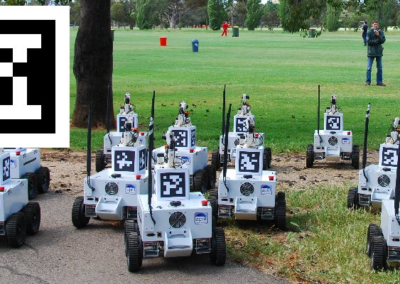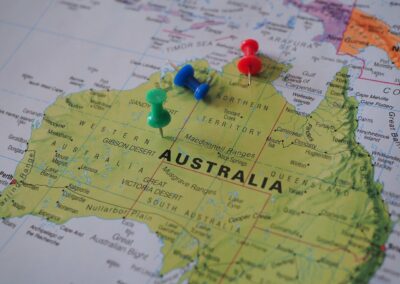Object tracking is a technology that allows computers to follow the movement of objects over time within a video frame. This technology relies on algorithms to detect and track objects, even as they move or change appearance. AprilTags, a type of fiducial marker, play a crucial role in this process by providing a simple and effective way to identify and monitor objects in various settings, from robotics to augmented reality.
In the upcoming pages, we’ll take a look into the world of object tracking, starting with the basics of how it works. We’ll explore different types of object tracking methods, focusing on the role of AprilTags (fiducial markers) in enhancing accuracy and reliability. Beyond the mechanics, we’ll also discuss the legal and ethical considerations that come into play when deploying object-tracking technologies. By the end of this article, you’ll have a comprehensive understanding of object tracking’s potential and its implications in the digital age.
The Origins of AprilTags
AprilTags originated from a project at the University of Michigan, designed as an intelligent yet simple solution for object identification and positional tracking. These fiducial markers consist of a black and white square pattern that resembles a simplified QR code which can be easily recognized by computer vision systems. Each tag contains a unique pattern that encodes an identifier, allowing it to be easily distinguished from others in the environment.
Types of Object Tracking

Object tracking technology has evolved to meet the needs of applications in various environments, from simple scenarios of tracking a single object to complex systems that monitor multiple items simultaneously. Whether it’s navigating through cluttered environments or distinguishing between objects in motion, the use of AprilTags has revolutionized tracking accuracy and reliability.
Single Object Tracking
Single object tracking focuses on monitoring the movement of one specific item within a video stream. This method is important in applications where a singular object’s precise location, movement, or behavior is of interest, such as following a specific person in surveillance footage or monitoring a robot’s position in an industrial setting.
Multiple Object Tracking
Multiple object tracking steps up the complexity, aiming to keep track of several objects simultaneously. This is particularly challenging due to occlusions, interactions, and similar appearances among objects. AprilTags help by assigning distinct identities to each object, allowing algorithms to keep track of each item individually, even in crowded or dynamic scenes.
Object Tracking in Different Environments
Object tracking is not limited to controlled or static environments. It thrives in varying conditions, from indoor spaces with consistent lighting to outdoor areas where lighting and weather can change unpredictably. The adaptability of AprilTags to different lighting conditions, angles, and distances makes them very important to ensure accurate tracking across different environments.
How Object Tracking Works

Object tracking operates by identifying and following objects as they move through a camera’s field of view. This process involves detecting the object in the initial frame and then using algorithms to predict its movement and location in subsequent frames. AprilTags play an important role by providing a recognizable pattern that simplifies the detection and tracking process. Up next, we’ll go into detail about the intricacies of object tracking, including the sensor technologies used, the algorithms and techniques of the tracking process, how data is processed and analyzed, and the critical role of AprilTags in enhancing the accuracy and efficiency of object tracking systems.
Sensor Technologies Used:
- Cameras: The primary sensors for capturing real-time video footage, allowing for the visual identification and tracking of objects marked with AprilTags.
- Infrared Sensors: Used in low-light conditions or to enhance tracking capabilities by detecting heat signatures and complementing visual data from cameras.
- LiDAR (Light Detection and Ranging): Uses laser beams to measure distances, which is useful in mapping environments and tracking objects in three dimensions.
- Ultrasonic Sensors: Use sound waves to detect the position of nearby objects, often used in robotics for obstacle avoidance and navigation.
- GPS (Global Positioning System): Provides location data for tracking objects over large distances, especially in outdoor applications.
Algorithms and Techniques
A blend of sophisticated algorithms and techniques ensures precise monitoring in object tracking. Pattern recognition is key for identifying distinctive markers like AprilTags, while machine learning algorithms continuously refine tracking accuracy by learning from data. Kalman filtering predicts future positions, improving the consistency of tracking. Optical flow analysis assists in detecting movement across frames, and deep learning, through neural networks, excels in recognizing and tracking objects in diverse and challenging environments.
Data Processing and Analysis
Data processing and analysis in object tracking involve collecting, filtering, and interpreting data from various sensors to accurately track objects. This process starts with raw data collection from cameras, LiDAR, or other sensors, which is then filtered to remove noise and irrelevant information. The data is analyzed to detect patterns, and algorithms are applied to determine the object’s location, movement, and trajectory, enabling precise and real-time tracking.
The Role of AprilTags (Fiducial Markers)
AprilTags play a vital role in enhancing the precision and reliability of object-tracking systems. These square, barcode-like markers are designed for easy detection by cameras and sensors, each encoding a unique identifier. When affixed to objects, AprilTags allow algorithms to quickly and accurately determine the object’s position and orientation. This capability is crucial for applications requiring high levels of accuracy, from robotics navigation to augmented reality experiences. The simplicity and effectiveness of AprilTags make them a preferred choice for researchers and engineers looking to minimize complexity while maximizing tracking performance in diverse environments.
Ethical and Legal Considerations
As we harness the power of tools like AprilTags, it’s essential to consider the implications on privacy, data security, and adherence to regulations. Upcoming discussions will delve into these critical areas, highlighting the balance between technological advancement and ethical responsibility.
Privacy Concerns
The use of object tracking raises significant privacy concerns, particularly in public or semi-public spaces where individuals might not expect to be monitored. Ensuring that the deployment of these technologies respects individuals’ privacy rights is of the highest importance. It involves transparently communicating the purpose of tracking, obtaining consent where necessary, and implementing measures to protect the identity of those being tracked. Balancing the benefits of object tracking with the right to privacy is a delicate and necessary endeavor.
Data Security
Securing the data collected through object tracking systems, especially when AprilTags are used, is critical to protect against unauthorized access and potential misuse. This includes using strong encryption methods, secure data storage solutions, and stringent access controls. Ensuring data security not only protects the individuals and objects being tracked but also builds trust in the technology and its applications.
Regulatory Compliance
Complying with existing regulations governing the use of surveillance and tracking technologies is non-negotiable. This encompasses understanding and adhering to local, national, and international laws that regulate data collection, storage, and processing. For implementers of object tracking systems, this means staying informed about the legal landscape, including GDPR in Europe or CCPA in California, and ensuring that their use of AprilTags and related technologies aligns with these regulatory frameworks, protecting both the users and subjects of the technology.
An Overview of Object Tracking with AprilTags
Today, we explored the intricacies of object tracking, emphasizing the role of in enhancing accuracy across various applications. We looked into sensor technologies, algorithms, data processing, and critical ethical and legal considerations, including privacy, data security, and regulatory compliance. Understanding these aspects is vital for responsibly using object-tracking technologies in a world where digital innovation intersects with ethical responsibility.







